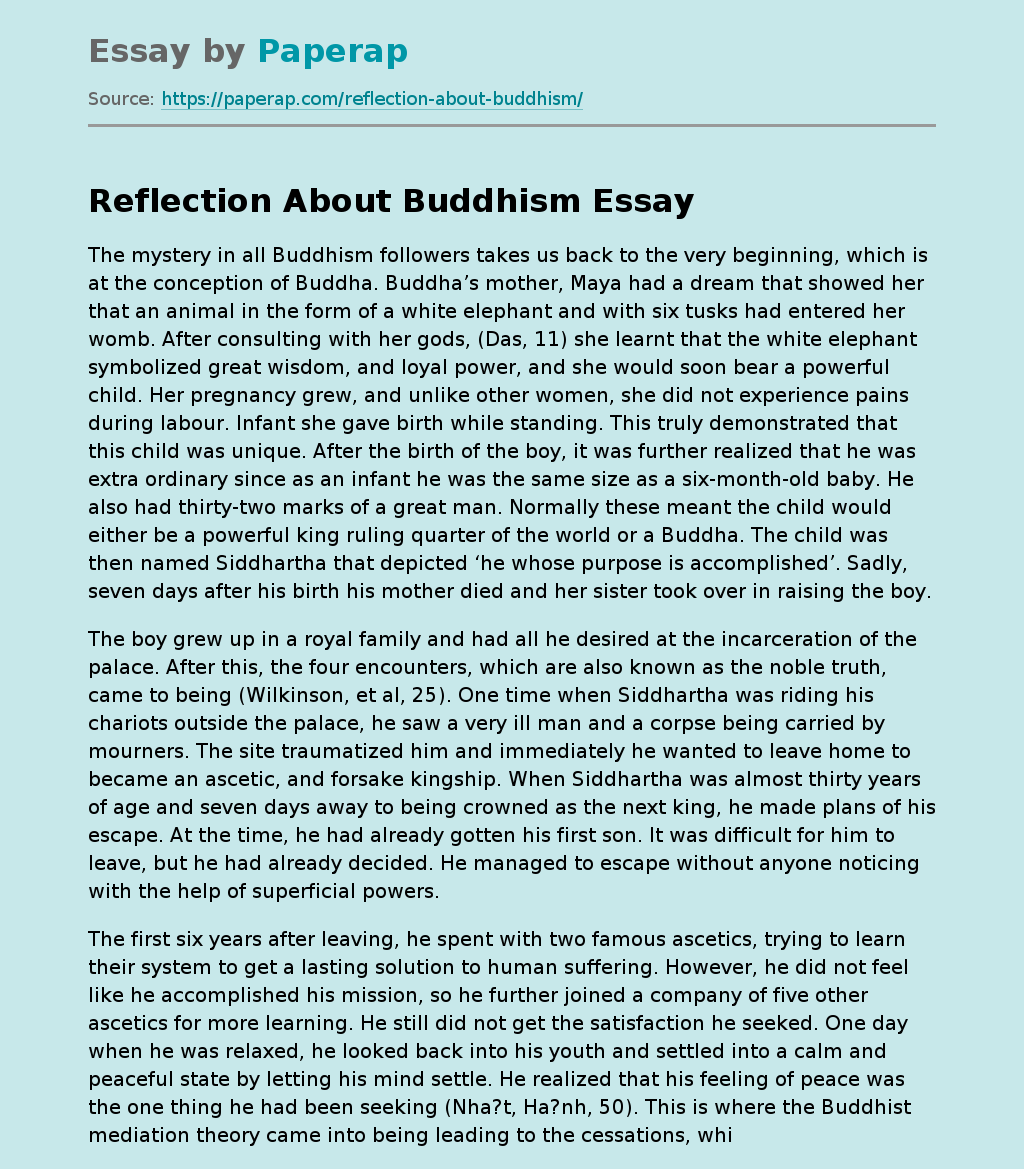In the following sample essay on the topic of reflection on the mystery of Buddhism. Read the introduction, body and conclusion of the essay, scroll down.
The mystery in all Buddhism followers takes us back to the very beginning, which is at the conception of Buddha. Buddha’s mother, Maya had a dream that showed her that an animal in the form of a white elephant and with six tusks had entered her womb. After consulting with her gods, (Das, 11) she learnt that the white elephant symbolized great wisdom, and loyal power, and she would soon bear a powerful child.
Her pregnancy grew, and unlike other women, she did not experience pains during labour. Infant she gave birth while standing. This truly demonstrated that this child was unique. After the birth of the boy, it was further realized that he was extra ordinary since as an infant he was the same size as a six-month-old baby. He also had thirty-two marks of a great man.
Normally these meant the child would either be a powerful king ruling quarter of the world or a Buddha. The child was then named Siddhartha that depicted ‘he whose purpose is accomplished’. Sadly, seven days after his birth his mother died and her sister took over in raising the boy.
The boy grew up in a royal family and had all he desired at the incarceration of the palace. After this, the four encounters, which are also known as the noble truth, came to being (Wilkinson, et al, 25).
One time when Siddhartha was riding his chariots outside the palace, he saw a very ill man and a corpse being carried by mourners. The site traumatized him and immediately he wanted to leave home to became an ascetic, and forsake kingship. When Siddhartha was almost thirty years of age and seven days away to being crowned as the next king, he made plans of his escape. At the time, he had already gotten his first son. It was difficult for him to leave, but he had already decided. He managed to escape without anyone noticing with the help of superficial powers.
The first six years after leaving, he spent with two famous ascetics, trying to learn their system to get a lasting solution to human suffering. However, he did not feel like he accomplished his mission, so he further joined a company of five other ascetics for more learning. He still did not get the satisfaction he seeked. One day when he was relaxed, he looked back into his youth and settled into a calm and peaceful state by letting his mind settle. He realized that his feeling of peace was the one thing he had been seeking (Nha?t, Ha?nh, 50). This is where the Buddhist mediation theory came into being leading to the cessations, which are known as four noble truths
The first noble truth stated that life is full of suffering and hence at some point in life everyone gets to experience suffering (Bstan-?dzin-rgya-mtsho, 23). The second noble statement was that suffering is caused by attachments. This meant that it is the attachments that we bind ourselves with that cause suffering. For instance, if we bind ourselves with anger and ignorance, suffering will surely follow us. Thirdly, the noble truth stated that abandoning our attachments brings release to suffering. This clearly teaches us that if we learn to let go of bindings such as pain and anger, we can attain peace, which in return reduces suffering (Novak, Philip, 69). Finally, the last noble truth tells us that we can release bindings by practicing the eight fold paths which consists of, right opinion, right intension, right conduct, right effort, right concentration, right speech, right livelihood and right mindfulness
This particular Zen Koan is rather interesting as it proves to us that mindfulness is particularly important (Huikai, 62). It states that on a windy day, two men were arguing about a shaking banner. The first said, “The banner is moving and not the wind”. While the second said that, the wind was moving and not the banner. A third person happened to pass by and uttered to them that it was neither the wind nor the banner that was moving but the minds of the two men. To avoid suffering one should perceive to live a life filled with good morals, charitable behaviour, mediation, perseverance and most importantly keep the four noble truths at heart.
Work cited
- Bstan-dzin-rgya-mtsho. The Four Noble Truths. New York: Mystic Fire Audio, 1997. Sound recording.
- Das, Gupta S. Buddhism, Reflection on Religious Conversion. New Delhi, India: Cyber Tech Publications, 2010. Print.
- Gard, Richard A. Buddhism. New York: G. Braziller, 1961. Print.
- Gethin, Rupert. The Foundations of Buddhism. New York: Oxford University Press, 1998. Internet resource.
- Hirota, Dennis. Toward a Contemporary Understanding of Pure Land Buddhism: Creating a Shin Buddhist Theology in a Religiously Plural World. Albany, N.Y: State University of New York Press, 2000. Internet resource.
- Huikai, and Thomas F. Cleary. No Barrier: Unlocking the Zen Koan : a New Translation of the Zen Classic Wumenguan (mumonkan). New York: Bantam Books, 1993. Print.
- Humphreys, Christmas. Buddhism. London: Cassell, 1962. Print..
- Nha?t, Ha?nh. The Heart of the Buddha’s Teaching: Transforming Suffering into Peace, Joy & Liberation : the Four Noble Truths, the Noble Eightfold Path, and Other Basic Buddhist Teachings. New York: Broadway Books, 1999. Print.
- Novak, Philip. The World’s Wisdom: Sacred Texts of the World’s Religions. San Francisco, Calif.: HarperSanFrancisco, 1994. Print.
- Wilkinson, Philip, and Steve Teague. Buddhism. New York: DK Pub, 2003. Print
Reflection on the Mystery of Buddhism. (2019, Dec 05). Retrieved from https://paperap.com/reflection-about-buddhism/

